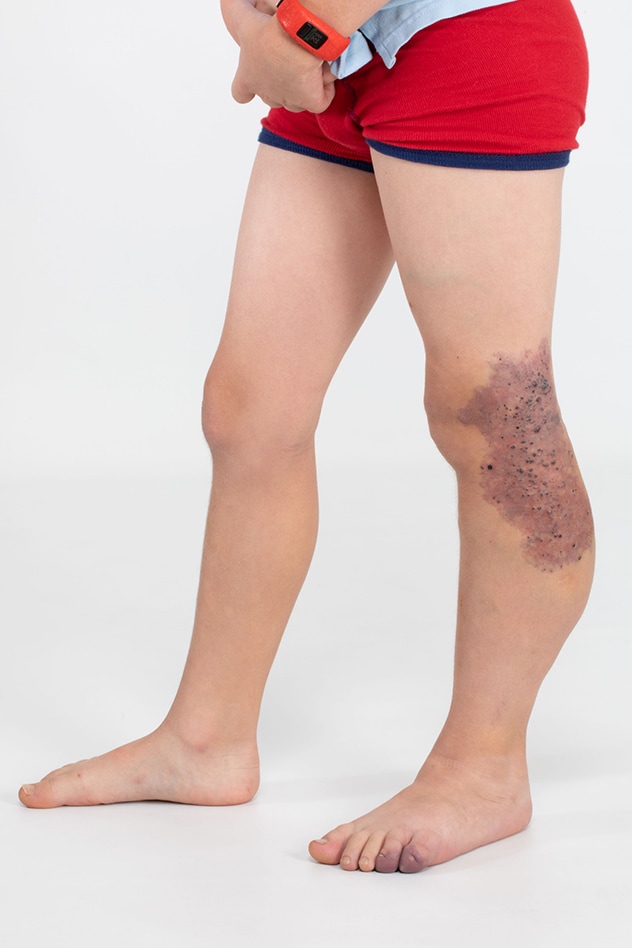May 31, 2025
Recent discoveries of key molecular pathways and genetic mutations responsible for the development and progression of vascular anomalies have significantly advanced the understanding of these conditions. Consequently, these insights have led to substantial improvements in diagnostic tools and treatment options. Understanding these pathways is critical for the classification of vascular anomalies, patient care and determination of appropriate therapeutic options.
"These malformations are typically caused by sporadic somatic variants, leading to mosaicism in which a patient has some cells with and some without the variant," says Brendan C. Lanpher, M.D., a medical geneticist at Mayo Clinic in Rochester, Minnesota. "Genetic testing for patients with vascular malformations is critical for making a specific diagnosis for effective treatment planning."
Mayo Clinic Children's vascular malformation specialty clinic provides specialized diagnostics and care for children with complex or rare vascular diseases. The team, comprised of multidisciplinary specialists, uses critical genetic testing that helps inform a multifaceted treatment plan.
About two years ago, the vascular malformation specialty clinic began significantly transitioning its approach to genetic testing. Most vascular malformations are caused by mosaic variants that arise in early development, after conception. A new testing approach uses ultradeep sequencing, designed specifically to find variants present in a tiny fraction of DNA. This has far greater sensitivity for mosaic variants compared with the more commonly used next-generation sequencing techniques such as whole-exome or genome sequencing. "From a genetic standpoint, this has changed the diagnostic yield for these types of patients from about 2% to well over 80%," says Dr. Lanpher. This new approach has been quite transformative — leading to more precisely targeted and personalized treatment options and medication choices.
 Klippel-Trenaunay syndrome
Klippel-Trenaunay syndrome
Signs of Klippel-Trenaunay syndrome in the lower leg.
 Congenital lipomatous overgrowth syndrome
Congenital lipomatous overgrowth syndrome
Signs of CLOVES syndrome in the lower leg.
The vascular malformation clinic is led by Megha M. Tollefson, M.D., a pediatric dermatologist at Mayo Clinic. It includes experts from a wide range of specialties including dermatology, interventional radiology, surgery, hematology and oncology, and genetics. The group has expertise and experience with a wide range of vascular malformations that includes capillary malformations, venous malformations, lymphatic malformations, arteriovenous malformations, kaposiform hemangioendothelioma, kaposiform lymphangiomatosis, combined malformations, and rare syndromes such as Sturge-Weber syndrome, Klippel-Trenaunay syndrome and congenital lipomatous overgrowth syndrome (CLOVES).
"Our team of specialists meets regularly to discuss each patient's genetic testing, imaging and evaluations and to determine a plan of care," says Eva S. Kahn, M.S., a certified and licensed clinical genetic counselor at Mayo Clinic. "These conditions involve a lot of nuance, and accurate testing requires optimal sample selection. Knowing both the gene-phenotype relationships and the strength of the associations greatly helps laboratories in data interpretation and eventually in the clinical diagnosis and treatment."
Depending on a variety of factors, including malformation type and genetic components, these conditions can require entirely different sets of specialists, appointments and procedures. "For example, for one of our patients with CLOVES syndrome we used ultradeep sequencing of cell-free DNA from blood, which led us to a molecular diagnosis," says Dr. Lanpher. This discovery changed the course of the patient's treatment to a gene-targeted medication, leading to a significantly improved outcome.
CLOVES syndrome is a rare disorder characterized by tissue overgrowth and complex vascular anomalies. CLOVES syndrome is a nonhereditary disorder caused by somatic variants in a gene known as PIK3CA. Variants in this growth regulatory gene result in two sets of cells within the body: those with the variant and those without the variant. The cells with the abnormal copy of PIK3CA give rise to the abnormal tissue. Manifestations include lipomas; patchy overgrowth; vascular malformations, including lymphatic, capillary and venous tissues; epidermal nevi; and skeletal anomalies. These findings are typically present at birth and can vary widely in severity.
The liquid-biopsy cell-free DNA (cfDNA) test for genotyping vascular malformations and other mosaic conditions uses samples obtained without surgery. This testing looks for specific genetic variants in DNA fragments shed by vascular malformations. This approach is similar to established cfDNA assays for cancer and for prenatal screening for chromosome abnormalities.
Many of the known molecular causes of vascular malformations affect genes that organize and regulate growth. Many of these genes have medications specifically designed to target those growth signals. One important example is alpelisib for patients with PIK3CA-related vascular malformations. Identifying the specific driver of a patient's vascular malformation can allow for informed, targeted medications that can stabilize and improve outcomes.
"For our patients with CLOVES syndrome, and other complex disorders, we've found significant success in optimizing our access to these advancements in genetic testing," says Dr. Lanpher.
Rare and complex diseases can have a significant impact on a child's life. The highly specialized team at Mayo Clinic Children's combines its depth of experience and knowledge to collaborate across the clinical practice and manage the unique needs of patients with rare vascular diseases and disorders.
"With advancements like ultradeep sequencing of cell-free DNA, our multidisciplinary team can collaborate on individualized treatment strategies — with the ultimate goal of improving each patient's condition and quality of life," says Dr. Lanpher.
For more information
Refer a patient to Mayo Clinic.